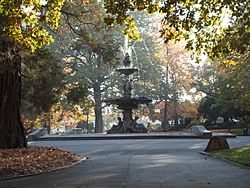Prince's Square facts for kids
Quick facts for kids Prince's Square |
|
|---|---|

The Val d'Osne Fountain in the central axis of the park
|
|
| Type | Public Park |
| Location | South-Central Business District of Launceston, Tasmania |
| Area | 1.25 hectares |
| Operated by | City of Launceston |
| Status | Open |
| Paths | Sealed paths |
| Terrain | valley floor, former clay pit |
| Water | fountain |
| Vegetation | European and exotic species |
| Connecting transport | Car, Bus |
| Facilities | Toilets, Picnic areas, drinking fountain |
Prince's Square is a beautiful park located in Launceston, Tasmania, Australia. It was created in 1858 from an old brick-making area. Today, it's a very important part of Launceston's culture and history. The park is famous for its neat, balanced design and its amazing bronze fountain called the Val d'Osne Fountain. The park is surrounded by Elizabeth Street, St John Street, Frederick Street, and Charles Street.
Contents
A Look Back: The Park's History
Prince's Square started as 'St John's Square' in 1826. At first, it was a big pit where people dug out clay. This clay was used to make bricks for Launceston's first permanent buildings. From 1824 to 1828, this clay pit helped build St John's Anglican Church. This church is still right across from the square today.
As Launceston grew, new clay pits were found elsewhere. The old pit then became a temporary rubbish dump for a while. But by 1843, soldiers started using it as a parade ground. People also began building homes and churches around the square. It slowly became a popular spot for locals to meet and relax.
Becoming a Grand Park
In 1851, St John's Square hosted an election for a new government group called the Legislative Council. Two years later, in 1853, Launceston became a proper town (a municipality). Also, a big movement led by Reverend John West stopped convicts from being sent to Tasmania. A huge celebration was held in the square to mark this important moment.
With a new sense of town pride, the local council decided to turn the square into a grand park. In 1858, they asked Thomas Wade, an expert from the Launceston Horticultural Society, to design it. People from the town and the society helped set up paths, fences, and plant trees. They planted Oaks, two giant Sequoias, and many other interesting plants. The famous fountain was put in place in 1859. The park officially opened on November 9, 1859. This was a big party to celebrate the Prince of Wales turning a certain age.
A Royal Visit and a New Name
In 1868, the Duke of Edinburgh visited Launceston. He planted two Oak trees in the square. A huge celebration took place with a choir, candlelight, and lights from the city's new gas supply. After this special event, the name of the square was changed from 'St John's Square' to 'Prince's Square'. This new name honored the Duke's visit.
The Val d'Osne Fountain
The Val d'Osne Fountain is 7 meters tall and is the main attraction in Prince's Square. It stands right in the middle of the park where the main paths meet. This amazing fountain was first shown at a big exhibition in Paris in 1855. Launceston's council bought it in 1859. They wanted it to celebrate the completion of Launceston's town water system in 1857.
The fountain was designed by a famous French artist named M.Lienard. The four large statues at the base were sculpted by M.Moreau. These statues show figures from old myths: Neptune, Galatea, Amphitrite, and Acis.
Fun Stories: Urban Legends About the Fountain
There are some fun local myths about the Val d'Osne Fountain.
The "Wrong Launceston" Myth
One popular story says the fountain was sent to Launceston by mistake! The myth suggests that Launceston in Cornwall, England, bought the fountain from France. But because both towns have the same name, it was accidentally shipped to Launceston, Tasmania. The story goes that it was too expensive to send it back, so the council just put it in the new square.
Historians say this story isn't true. Records show the council definitely bought the fountain. This myth might have started because a local newspaper in 1859 mentioned the fountain seemed very cheap. People thought such a grand fountain should cost more.
The "Pineapple Top" Myth
Another less known myth is about the very top part of the fountain. This story claims the original top was a half-naked figure that people thought was too rude. So, it was supposedly replaced with a 'pineapple'.
This myth is also incorrect. The top of the fountain is actually a bunch of reeds. Also, the catalog from which the council bought the fountain clearly shows the same top piece that is there today.
Churches Around the Square
Prince's Square is special because it has the most churches in the city. There are five churches facing the square, and two of them also have old homes for their leaders nearby. As the area grew, many spots around the square were chosen for churches and other buildings related to the Christian faith.
Here are the churches, listed by when they were built:
- 1824 St John's Church
- 1841 St John's Square Congregational Chapel (also known as Milton Hall)
- 1859 Chalmers' Presbyterian Church
- 1883 Christ Church Congregational Church (now called City Baptist Church)
- 1939 Gospel Hall

